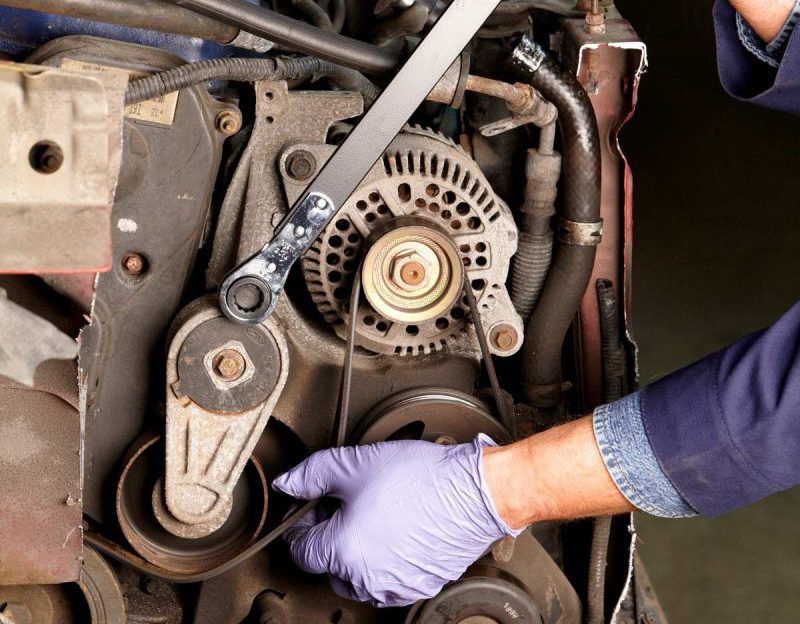If you own a vehicle, the term of belt tensioner must be familiar. Even though it is small, it is crucial. In fact, belt tensioners are one of the most critical parts in the whole system of the accessory belt drive. To be more precise, together with the serpentine belt, the car belt tensioner keeps the engine system working the right way. However, just like any other car components, we need to check it to make sure it is still working properly or in some cases, replace it. So before jumping into the related failure symptoms and maintenance, we need to familiarize ourselves with its definition and function.
Contents
The Definition of Automatic Belt Tensioner
In order to understand the automatic belt tensioner, we need to know the serpentine belt. If you take a look inside the engine, you can spot the part winding around many car components of the engine, from the air conditioning compressor, alternator, power steering pump, water pump, and many other parts. That component is the serpentine belt.
And to keep the serpentine belt tight and have enough tension while we are driving, we need the automatic belt tensioner. Without this belt tensioner, the belt does not have enough tension, which makes it impossible to move the pulley of the engine.
The Function of Automatic Belt Tensioner
To understand the function of this car component, we need to list out the parts that make it. For an automatic belt tensioner to work, we need four main parts.
The Spring
In order for the automatic belt tensioner to tighten the serpentine belt, we need the spring. In other words, this spring is the main aspect of the tensioner.
The Pulley
In order for the belt to travel over and over, we need a smooth and clean surface. The pulley is that particular surface. Along with that, the pulley also connects to the tensioner arm.
The Tensioner Arm
We also need the tensioner arm for the whole system to work. It provides you enough slack with the purpose of adjusting or removing the serpentine belt. Car owners can find this arm at the bottom of the components. In order for it to provide slack, pressing on the arm will act against the spring’s force.
The Base
Last but surely not least, we need the base to cover all of these parts. The base is the hard shell that packs everything inside.
The Maintenance of Automatic Belt Tensioner
Adjust the Automatic Belt Tensioner
Car owners must be able to adjust an automatic belt tensioner in order to do the maintenance. Before doing anything, you must turn off the engine and disconnect the negative end of the car battery. If you do not know the location of the belt system, it is on the side of the engine. To reach it, car owners need to raise the car by a jack and take off the front tires. In situations when the serpentine belt is tight and nice, you can leave it there. However, if it is not, we need to adjust.

Drivers need to have a socket and ratchet to perform the task of loosening or tightening the bolt. While doing this, move the serpentine belt with your hands until you can move or twist about half a turn by the thumb and index finger, you are done. That is the right tension we want.
Replace the Automatic Belt Tensioner
Alright, we now know how to replace the automatic belt tensioner. So how can we replace it when it is broken? Can we do it alone? The answer is yes, the driver can replace it alone.
In order to perform this task, we need to loosen the adjustment bolt first. The aim of this action is to slide the serpentine belt off the tensioner pulley. After that, we let the tensioner retract gradually. When the tensioner stopped, car owners needed to loosen the mounting bolt in the middle of the tensioner arm to remove it. Next, car owners can remove the belt tensioner from the engine block to install a new one. After that, tighten the mounting bolt and slide the serpentine belt onto the pulley. Also, you must keep in mind that the belt must be at the right tension and right place in relation to accessory pulleys and tensioner pulleys.
The Failure Symptoms of Automatic Belt Tensioner
A belt tensioner is a crucial part in the whole automatic system, which is why we need to know all its failure signs.
Loss of Spring Force
The first and most well-known problem with this car component is the loss of spring force. In most cases, we can spot this issue by moving the tensioner arm through the whole range of motion with a wrench. Usually, there will be resistance. If nothing happened, that means the spring has lost its force, which required the whole tensioner change.
SEE MORE
- The Easiest Ways To Remove Road Tar From Your Car
- Why Do I Have A Soft Brake Pedal? Causes And Solutions
Rust Cracks and Bleed
Another sign of a damaged automatic belt tensioner is the rust bleed and cracks. As we all know, rust is coming between the arm and base from the tensioner. It is really hard to notice since you can only spot some damage when removing the tensioner.
The main cause of this issue is the internal component wear, which occurs at mounting bolts along with tensioner stops. In order to fix this issue, car owners need to replace the tensioner.
Pulley Wear
Another symptom of a broken automatic belt tensioner is pulley wear. We all know pulleys are made from nylon, plastic and steel. They also have a grooved or flat surface with no cracks, dents, debris and chips. However, when the pulley wears, the grooves might be worn down. The cause of this problem is that the belt wears into the pulley, which requests the whole tensioner replacement. One thing to keep in mind is that you cannot replace a worn pulley in a used tensioner assembly. To solve this issue, car owners must change the entire set of tensioners since the damaged part will follow quickly.
Pulley Bearing Wear
Car owners can recognize the pulley bearing wear by rotating the pulley by hand. To be more specific, the noise, roughness or resistance of the pulley when the engine is off and the belt is removed can show this issue. When there is a defective bearing and pulley, we will mostly have pulley bearing wear. Car owners need to replace the whole tensioner to fix this problem.
Tensioner Noise
Another common problem with automatic belt tensioner is the tensioner noise that we can notice by the rattling and squeaking sound. The failure of the pivot area or bearings is the main cause. This also requires the whole tensioner replacement.
Tensioner Arm Misalignment
Car owners can also find some unusual belt tracking on tensioner pulleys which is another issue related to automatic belt tensioner. The contact between metal and metal, or arm and spring housing to be more specific, is the main factor. We can fix this problem by checking the pivot bushing and tensioner arm misalignment first. If they are worn down, we must change a new tensioner.

Tensioner Assembly Misalignment
If you are having abnormal belt tracking on the tensioner pulley, there is a high chance that you are having tensioner assembly misalignment. The cause of this problem is either bent, misaligned mounting bracket or wrong tensioner installation. Another factor can be the contamination or corrosion between mounting surface or tensioner base.
Car owners can easily fix this by using a laser alignment tool. However, if the misalignment persists, we need to change the tensioner.
Grinding or Binding Tensioner Arm Movement
Binding or grinding tensioner arm movement is one of the most common problems of automatic belt tensioner. If you can feel this from your vehicle, you need to change the tensioner arm quickly.
Excessive Tensioner Arm Oscillation
Last but certainly not least, we have excessive tensioner arm oscillation. We can spot this issue by checking if there is any back and forth sway from the arm of the tensioner when working. The overrunning alternator pulley failure or the torsional vibration damper can be the cause of this issue.
If you want to fix the excessive tensioner arm oscillation, you need to take a look at the condition of both pulley and damper. If they are damaged, you must change the tensioner.
In Conclusion
Now that we know what the automatic belt tensioner means, its functions, maintenance as well as its failure signs. The belt tensioner is a complicated and connected system, so if there is something wrong with it, we might need to consider changing the whole tensioner.



